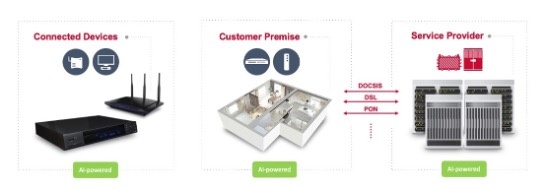The Transformative Impact of AI on the Broadband Experience
The rise of Generative Artificial Intelligence
It’s hard to avoid discussions of Artificial Intelligence nowadays. There’s no shortage of commentary describing how the transformative power of this technology is going to change everything from business to transportation to the home.
I couldn’t agree more. What’s less widely known is that the Broadcom Video Group began AI projects about a decade ago with the goal of transforming the broadband consumer experience. I’ll get to that shortly but first, let’s take a brief look at what this technology means for the future of smart homes.
AI in the Home
AI has come a long way in a relatively short time, evolving from basic automation systems to encompass a wide range of devices and services and transforming how we interact with our living spaces.
The concept got put into practice as developers invented algorithms that could control lighting, temperature, and security. But the development of personal assistants and voice recognition technology such as Alexa – named in homage to the library of Alexandria – helped usher in a new era with users using natural language commands as they interacted with their smartphones, video and home devices over a broadband connection.
As broadband access networks and home automation became a reality with the development of smart home devices and the growth of the Internet of Things, AI assumed an increasingly visible role in the home. The debut of broadband-enabled home devices, such as smart TVs and Set-Top Boxes, represented a new generation of products featuring AI algorithms capable of learning user preferences and adapting to behavior patterns to provide personalized experiences.
As AI-powered smart home devices became more common, the focus shifted towards integrating different systems for seamless control.
Thanks to these sundry advancements in machine learning on natural language processing and video object detection and classification, AI-powered home assistants also grew more sophisticated. They could understand context, provide personalized recommendations, and learn from user interactions. It also meant that users were no longer confined to using simple voice-controlled devices; now they could avail themselves of more robust systems capable of managing schedules, answering questions, controlling multiple devices, and even engaging in basic conversations.
These AI-driven smart access networking and home device ecosystems encompassed myriad aspects of home automation. They combined AI assistants, smart speakers, connected appliances, energy management systems, and other devices to create integrated smart home experiences.
It was no longer a pipe dream to think about a future in which users controlled and monitored their homes remotely, received alerts, and automated routine tasks based on preferences and behavior patterns. That future had arrived in the form of intelligent devices – everything from the Roomba to smart refrigerators and washing machines to AI-enabled smart routers and home entertainment systems.
As AI-powered smart home devices became more common, the focus shifted towards integrating different systems for seamless control. The subsequent development of smart home hubs and platforms helped to unify disparate devices and enable centralized management. Users could now control multiple aspects of their homes using a single interface or voice commands, enhancing convenience and efficiency.

Broadcom and AI
What’s less widely known is the behind-the-scenes role that Broadcom has played in this transition by increasing the amount of edge computing power to drive greater AI/ML development. Indeed, Broadcom's integration of AI and machine learning capabilities in its set-top boxes and broadband communications devices has effected dramatic changes in the way end-users interact with these devices. Consider the following:
- AI Video: Set Top Boxes allow for facial recognition-based user profiles and video calling. They also paved the way for increased resolution output to 4K or even 8K with local video sharpening and noise reduction. What’s more, they led to the Picture in a Picture advance with zoom-in/ zoom-out controls.
- AI Voice: Thanks to Broadcom’s AI technology, end-users can conduct voice-based search with both “push-to-talk” and far-field voice inputs. They also benefit from improved performance when it comes to voice-based user profiles, as well as text-to-speech and speech-to-text.
- AI Apps: Improved user experience thanks to better security that keeps personal information local and off the cloud. Also, AI personalizes content and recommendations, making them more relevant to the end-user.
Broadcom pioneered the deployment of AI to help support teams identify problems with broadband consumer premises equipment (CPE) devices and how to resolve them, saving both time and money. Broadcom's Analytic System (BAS) uses AI to help diagnose, manage, and secure both STBs and other CPE devices.
BAS delivers advanced visibility into packet flows at the switch and network level. That offers service providers improved visibility into network traffic, including the source and destination of packets, the type of traffic, and the amount of traffic. This information can be used to identify and troubleshoot network problems, as well as to optimize network performance. In a ruthlessly competitive business, it’s hard to overstate the benefits reaped by service providers. Particularly when it comes to:
- Reducing operating expenses and eliminating technician visits: service providers can lower their operational costs by automating many tasks that have historically been performed manually. For example, the system automatically identifies and troubleshoots network problems, as well optimizes network performance.
- Improving user experience: better service and fewer disruptions translate into reduced customer churn.
- Preventing piracy / theft and enhancing cybersecurity: BAS identifies and then tracks malicious activity on the network. Security managers can then use that information to prevent and mitigate threats.
These are only the coming attractions. Just as we helped transform the broadband consumer experience in years past, Broadcom’s investment in leading-edge technologies such as AI/ML reflects our intent to remain on the leading edge of development as we spearhead the continuing evolution of smart homes.
The future of smart homes is bright and we’re going to deploy our expertise to illuminate the path. Learn more about Broadcom’s broadband silicon platforms.

Silicon Powers Democratized Networking
Chips are the heartbeat of the global network ecosystem








We encourage you to share your thoughts on your favorite social platform.